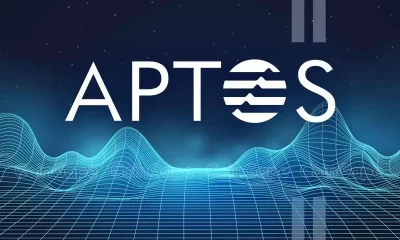Adoption
Crypto traders choose to spend rather than HODL
Published
4 months agoon
By
admin
Disclosure: The views and opinions expressed here belong solely to the author and do not represent the views and opinions of crypto.news’ editorial.
HODL has been the time-honored philosophy of Bitcoin (BTC) holders. Rather than spending their growing wealth, those who own the biggest cryptocurrency have chosen to ‘hold on for dear life’ with an evangelistic zeal. Nevertheless, while Bitcoin, the king of crypto, continues to capture the headlines, the cryptocurrency space is in a very different place now from where it was just a few years ago.
Dogecoin (DOGE) may have been launched in 2013, but it is currently in the cycle of an explosion of interest in memecoins. While this market has unfortunately been prey to scams and pump-and-dump schemes, the growth and increasing significance of meme coins is an undeniable fact.
Meanwhile, the architecture and payment rails of the space have also changed dramatically. In the past, Bitcoin holders who chose to sell their holdings and off-ramp rather than HODL often had to rely upon shady intermediaries, exorbitant fees, and snail-paced processing times. Now, holders of cryptocurrency have a variety of options for off-ramping, with payment specialists in the web3 space forming partnerships with giants from the TradFi space, such as Mastercard. Off-ramping from digital tokens into a fiat currency can now be done in a seamless and secure way with low fees and charges.
Meme coin frenzy
In the current bull market cycle, which has seen Bitcoin pierce a new all-time high above $97,000, the market capitalization of meme coins has skyrocketed from $56 billion to $118 billion following Trump’s re-election and a subsequent crypto bull run.
Originally created as a joke based on the ‘Doge’ meme featuring a Shiba Inu dog, DOGE is the biggest and most recognisable meme coin. Many meme coins are also named after endearing animals, one example being Moo Deng (MOODENG), the baby pygmy hippopotamus living in a Thai zoo.
Elon Musk’s appointment to President-elect Donald Trump’s cabinet as head of the new Department of Government Efficiency, DOGE, has fueled DOGE’s ascent, with the digital token now having a market capitalization of $58 billion. We’re now witnessing tens of thousands of meme coins attempting to emulate DOGE’s success being created each day on Pump.Fun, a Solana-based tool that removes technical barriers to developing the tokens.
Crypto traders are FOMing into newly launched meme coins, often for just a few dollars, in the hope that the token will capture a cult-like following and soar in value. Non-custodial wallet Phantom, which provides users with an array of opportunities to bet on meme coins, has been propelled to the second spot on the charts in the utility section of the Apple App Store in the US. Those who make winning bets on meme coins often swap the tokens into established cryptocurrencies such as Solana to lock in profits and as a bridge before converting their holdings into a fiat currency.
End of creaky payment rails
The cryptocurrency space has evolved to a point where it is almost unrecognizable from where it was a decade ago. Notably, Mastercard and Visa have now entered the web3 ecosystem. Mercuryo’s Mastercard crypto debit card, Spend, bridges the gap between non-custodial crypto wallets and traditional payment methods. Spend is a plug-and-play solution that can be quickly integrated into a non-custodial wallet and rolled out to users who can add it to their Apple Pay or Google Play wallet. Spend is available to use online and in-store across Mastercard’s 100 million-plus network of merchants, providing users with a seamless, low-cost means of off-ramping their crypto holdings. Holders of the Spend card benefit from a level of consumer protection on a par with a traditional debit or credit card.
The cryptocurrency space is continually evolving. The growing significance of meme coins has partly been driven by Generation Z’s dominance of social media channels such as Instagram, TikTok, and X. These social channels provide a public forum for newly launched meme coins to go viral and obtain a cult-like following.
At the same time, we are witnessing the emergence of new payment products that provide crypto traders with an accessible and low-cost means of spending their trading profits. While the philosophy of HODL still resonates strongly with Bitcoin evangelists, newcomers to the web3 space arguably have more of a ‘live-for-today’ philosophy. Driven by a belief that life is short and crypto profits should be spent, these consumers are taking advantage of payment products that facilitate the off-ramping of cryptocurrency at a low cost. While it is pure speculation to guess how long the current crypto bull market will go on, what’s certain is that the market is continuing to evolve at a breakneck pace. This is reflected in a somewhat comedic fashion with the meme coin mania that we’ve been witnessing but also in the increasing sophistication of payment products in the space. These off-ramping services have levels of compliance and protection that are on par with payment products from traditional finance and enable people to spend their newfound crypto wealth in the real world.

Greg Waisman
Greg Waisman is the co-founder and chief operating officer of the crypto wallet service Mercuryo. He has been creating products for over 10 years: he takes the idea and turns it into a working product with a real audience. Greg has extensive experience in managing cross-functional teams.
Source link
You may like


Dogecoin Follows This Blueprint, Says Crypto Analyst


Metaplanet Buys Additional ¥3.8 Billion Worth Of Bitcoin


Crypto Trader Unveils Massive Bitcoin Price Target Amid Extended BTC Bull Market – Here’s His Outlook


Is it possible to make $1m with crypto?


Japan’s Metaplanet Buys Another $26M in Bitcoin Amid Tariff Market Uncertainty


Has Ethereum Price Bottomed? 3 Reason Why ETH Could Crash More
Adoption
Toulouse starts to accept crypto for public transport
Published
2 weeks agoon
March 31, 2025By
admin

In Toulouse, France, residents can pay for their metro, tram, cable car, and bus tickets with Bitcoin and other cryptocurrencies.
In fact, starting on March 17, Toulouse became the first European city where crypto can legally be spent on public transport.
European Premiere: Crypto for Tram Fares!
With @Lyzi_app and @tisseo_officiel, you can now get around Toulouse using your crypto holdings; marking them as the first European public transport system to test this!
Metro, tram, bus, cable car, and park & ride – they’re all… pic.twitter.com/2lKfEUCJYU
— Lyzi
(@Lyzi_app) March 20, 2025
The move comes as France actively seeks to deploy various crypto-friendly services. It is reported that Cannes is also working on a payment system that will accept crypto from residents.
Tisséo, a Toulouse public transport operator, launched its solution first. The tickets can be bought via an Android-based mobile app for Bitcoin or one of the 70 altcoins. The crypto is instantly converted to euros. Binance Pay is among the supported payment options.
According to the deputy mayor of Toulouse, Sacha Briand, the initiative is experimental as the company wants to check how widespread the use of crypto can become in the long run. The press release emphasizes that the Toulouse administration is interested in the long-term prospects of cryptocurrency integration.
It’s worth noting that Paris-based Lyzi developed the crypto payment infrastructure for Tisséo. This white-label fintech company actively helps other businesses, including pharmacies, coworking spaces, and restaurants, accept crypto payments.
Lyzi also facilitates crypto payments for Printemps fashion stores across France.
They accept binancepay. They don’t accept Bitcoin
— Oliver Koblížek
(@Stromens) March 24, 2025
Some of the Bitcoin maxis have already expressed discontent over the fact that the service involves an intermediary of Binance, as they disapprove of the use of any middlemen or altcoins.
Advocates of the move by Tisséo argue that having Binance involved was important to ensure the speedy execution of transactions.
A more serious hurdle is the necessity to declare crypto transactions via tax form 3916-bis. Crypto transactions incur a 30% capital gains tax. Time will tell how easy it is. Regulators will likely have to adjust the rules to make crypto payments easier. The stats indicating how many people use the new payment avenue are unavailable as of press time.
Crypto in France
France is one of the countries that adopted general crypto regulations in 2020, making cryptocurrency storage and transactions legal and inspectable as France complies with the AML rules.
The press release dedicated to the crypto implementation in Toulouse mentions that cryptocurrency is becoming more popular among the French. The 2024 report by Gemini indicates that around 18% of French citizens hold crypto. Tisséo’s adoption of crypto payments for city transit was made in anticipation of the further growth in the number of crypto owners.
While the new initiative can attract more people’s interest in owning crypto, it may also create a robust infrastructure where people can use crypto for daily purchases once the share of crypto holders becomes critical.
Bitcoin cities
Although Toulouse became the first European city to let residents use crypto to pay for public transport, several other countries boast various services that can be paid for in crypto:
- Argentina: In 2019, Argentina allowed its citizens to top up the SUBE cards used in around 60 cities to pay for public transport with crypto.
- United Arab Emirates: Dubai is arguably one of the first so-called “Bitcoin cities” that come to mind when considering places to spend Bitcoins. Although Bitcoin is not registered as a legal tender in the United Arab Emirates, it can be spent there in hotels, malls, and restaurants. It is possible to rent a vehicle or book a flight using Bitcoin. Real estate purchases are also possible via crypto in Dubai. Those who don’t feel confident using online crypto exchanges may use one of the city’s crypto ATMs.
- Switzerland: Another notable example is the city of Zug, dubbed “Crypto Valley.” The city hosts the same crypto conference, while Switzerland itself is a well-known cryptocurrency hub. Zug allowed its residents to pay in Bitcoin for services (i.e., taxes) back in 2016.
- China: Hong Kong, considered a special administrative region, is another place where people can pay for dinner with Bitcoin. Immigrants can also use Bitcoin, Ethereum, and other digital assets as proof of wealth when visiting Hong Kong.
Source link
Adoption
HK Asia Holdings Becomes First In China To Adopt Bitcoin Treasury
Published
3 weeks agoon
March 25, 2025By
admin
HK Asia Holdings (HKEX: 1723), soon to be renamed Moon Inc., has made history as the first publicly traded company in Greater China to adopt a Bitcoin treasury strategy. In a recent discussion hosted by Allen Helm of Bitcoin For Corporations, new CEO John Riggins outlined the company’s pivot, its regulatory alignment with Hong Kong, and the broader momentum building across Asia.
Riggins, a longtime Bitcoin advocate with extensive experience across China and Southeast Asia, explained that the move was driven by both long-term conviction and a favorable shift in regulatory posture in Hong Kong. He said the company had spent months consulting with regulators, public market investors, and local partners before executing the transition.
Originally focused on SIM cards and prepaid tech products, HK Asia Holdings now aims to integrate Bitcoin both as a balance sheet asset and into its business model. This includes plans to roll out Bitcoin-related offerings through its retail footprint, such as ATMs and prepaid Bitcoin products.
The company’s first steps included the acquisition of 8.88 BTC during a post-acquisition period, followed by another 10 BTC purchase once the leadership transition was finalized—bringing its total holdings to 18.88 BTC, valued at over $1.7 million at the time of announcement. Riggins said further accumulation is planned, though it will proceed in accordance with Hong Kong’s measured but transparent regulatory guidance.
“We see it as a way to protect our balance sheet, and we see it as a way to diversify, our treasury with an eye on how the rest of the world is moving,” said Riggins.
The strategic intent goes far beyond speculation. Riggins framed Bitcoin as a hedge against macro uncertainty, a tool for long-term resilience, and a bridge to emerging global financial infrastructure. He also emphasized how corporate boards in the region are beginning to engage more seriously with the idea, pointing to MetaPlanet in Japan and Strategy in the U.S. as compelling precedents.
While Asia’s corporate Bitcoin adoption is still in its early stages, interest is growing fast. Riggins highlighted South Korea, Thailand, Malaysia, and Indonesia as markets with clear potential to follow suit. Much of the movement, he noted, is happening quietly behind the scenes—especially in China, where institutional stakeholders and state-connected investors are actively monitoring U.S. policy shifts and corporate adoption trends.
“I’m flooded with messages more and more from, people in the government, people, you know, institutional investors who are kinda watching this space closely looking for inside information about what’s happening here,” said Riggins.
Although no formal public moves have been announced by Chinese state entities, Riggins believes Bitcoin is already being held indirectly through government-affiliated organizations, including state-connected investment arms. He suggested these holdings may be more significant than publicly known. With the U.S. moving toward a strategic Bitcoin reserve, he sees China closely watching—and potentially following—if global policy momentum continues to shift.
Looking ahead, Moon Inc. plans to expand its Bitcoin holdings within Hong Kong’s regulatory framework and serve as a model for other Asian companies exploring similar strategies. The company will co-host Bitcoin Asia this August in Hong Kong, positioning itself as a regional trailblazer and helping catalyze broader corporate adoption across Asia.
Disclaimer: This content was written on behalf of Bitcoin For Corporations. This article is intended solely for informational purposes and should not be interpreted as an invitation or solicitation to acquire, purchase, or subscribe for securities. For full transparency, please note that BTC Inc., the parent company of UTXO Management, holds a stake in HK Asia Holdings Limited (1723.HK) in partnership with Sora Ventures and other entities.
Source link
Adoption
California Senator endorses Bitcoiner for seat on $500b pension fund board
Published
1 month agoon
March 12, 2025By
admin

California State Senator Ben Allen is eyeing further pro-crypto representation with an endorsement of Dom Bei for election to the board of California’s public pension fund.
Bei is the founder of Proof of Workforce, a Bitcoin (BTC) non-profit focused on promoting BTC adoption via educational initiatives targeting workers, unions and pension funds. He is in the race to join the California Public Employees’ Retirement System, CalPERS, as a board member.
Notably, CalPERS is the largest public pension fund in the United States with over $500 billion and serves more than 2 million public retirement system members. CalPERS manages the retirement assets of California’s police department, firefighters and teachers among others.
The pension fund also counts over 1.5 million individuals as members of its health program.
CalPERS board of trustees comprises 13 members. Endorsement from Sen. Allen could see Bei become the first bitcoin advocate to get elected.
“I’ve dedicated over a decade to championing workers and wage-earners. Now, I’m running for CalPERS Board of Trustees to protect our nation’s largest public pension, serving 2M+ participants,” Bei noted in a post on X.
The former firefighter previously served on the advisory board of the Santa Monica pension fund. His pro-bitcoin voice has seen him get support from across several players in the industry.
According to observers, election to CalPERS will be crucial to the overall push for BTC adoption across pensions and other public sector platforms. With his experience and as a Bitcoin holder, Bei could see the largest pension fund in the U.S. explore and potentially add the flagship digital asset to its holdings.
Other than Senator Allen, Bei has received endorsements from more than dozen state legislators. Santa Monica mayor Lana Negrete and California treasurer candidate Tony Vazquez have also talked up his chances. Meanwhile, Anthony Pompliano, founder and chief executive officer of Professional Capital Management, has also added his support.
In 2024, several pension and endowment funds disclosed exposure to Bitcoin, with this coming amid the rapid adoption that followed the Securities and Exchange Commission’s approval of the first spot BTC exchange-traded funds. They include state pension funds and multiple university endowment funds.
Source link

Dogecoin Follows This Blueprint, Says Crypto Analyst

Metaplanet Buys Additional ¥3.8 Billion Worth Of Bitcoin

Crypto Trader Unveils Massive Bitcoin Price Target Amid Extended BTC Bull Market – Here’s His Outlook

Is it possible to make $1m with crypto?

Japan’s Metaplanet Buys Another $26M in Bitcoin Amid Tariff Market Uncertainty

Has Ethereum Price Bottomed? 3 Reason Why ETH Could Crash More
Michael Saylor Teases New Bitcoin Buy After Strategy’s $7.69 Billion Q1 BTC Buying Spree

Crypto markets ‘relatively orderly’ despite Trump tariff chaos: NYDIG

Fartcoin ‘Hot Air Rises’ — $1.50 Just A Whiff Away

What happened to the RWA token?

Crypto Strategist Sees Solana-Based Memecoin Surging Higher, Says One AI Altcoin Flashing Strong Chart

Mantra Team Responds As The OM Token Price Crashes Over 80% In 24 Hours

This Week in Crypto Games: Gaming Tokens Crash Out, Eve Frontier Opens Up

Commerce Secretary Lutnick walks back tariff relief on electronics

Gold ETF Inflows Hit Three-Year High as PAXG, XAUT Outperform Wider Crypto Market

Arthur Hayes, Murad’s Prediction For Meme Coins, AI & DeFi Coins For 2025

Expert Sees Bitcoin Dipping To $50K While Bullish Signs Persist

Aptos Leverages Chainlink To Enhance Scalability and Data Access

Bitcoin Could Rally to $80,000 on the Eve of US Elections

Crypto’s Big Trump Gamble Is Risky

Institutional Investors Go All In on Crypto as 57% Plan to Boost Allocations as Bull Run Heats Up, Sygnum Survey Reveals

Sonic Now ‘Golden Standard’ of Layer-2s After Scaling Transactions to 16,000+ per Second, Says Andre Cronje

Ripple-SEC Case Ends, But These 3 Rivals Could Jump 500x

Has The Bitcoin Price Already Peaked?

A16z-backed Espresso announces mainnet launch of core product

The Future of Bitcoin: Scaling, Institutional Adoption, and Strategic Reserves with Rich Rines

3 Voting Polls Show Why Ripple’s XRP Price Could Hit $10 Soon

Xmas Altcoin Rally Insights by BNM Agent I

Blockchain groups challenge new broker reporting rule

I’m Grateful for Trump’s Embrace of Bitcoin
Trending

 24/7 Cryptocurrency News5 months ago
24/7 Cryptocurrency News5 months agoArthur Hayes, Murad’s Prediction For Meme Coins, AI & DeFi Coins For 2025

 Bitcoin3 months ago
Bitcoin3 months agoExpert Sees Bitcoin Dipping To $50K While Bullish Signs Persist

 24/7 Cryptocurrency News3 months ago
24/7 Cryptocurrency News3 months agoAptos Leverages Chainlink To Enhance Scalability and Data Access

 Bitcoin5 months ago
Bitcoin5 months agoBitcoin Could Rally to $80,000 on the Eve of US Elections

 Opinion5 months ago
Opinion5 months agoCrypto’s Big Trump Gamble Is Risky

 Bitcoin5 months ago
Bitcoin5 months agoInstitutional Investors Go All In on Crypto as 57% Plan to Boost Allocations as Bull Run Heats Up, Sygnum Survey Reveals

 Altcoins2 months ago
Altcoins2 months agoSonic Now ‘Golden Standard’ of Layer-2s After Scaling Transactions to 16,000+ per Second, Says Andre Cronje

 Price analysis5 months ago
Price analysis5 months agoRipple-SEC Case Ends, But These 3 Rivals Could Jump 500x



